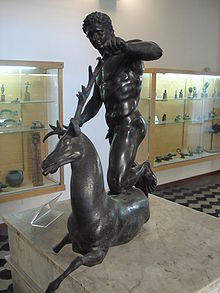- Ceryneian Hind
-
Ceryneian Hind AKA: Cerynitis 
Heracles and the Ceryneian Hind. Bronze fountain, 1st century B.C.Mythology Greek mythology Grouping Legendary creature Country Greece Region Keryneia, Greece
In Greek mythology, the Ceryneian Hind (Greek: ἡ Κερυνῖτις ἔλαφος), also called Cerynitis, was an enormous hind (deer), who lived in Keryneia, Greece. It was sacred to Artemis, the chaste goddess of the hunt, animals and unmarried women. It had golden antlers like a stag and hooves of bronze or brass, and it was said that it could outrun an arrow in flight. The capture of the hind was one of The Twelve Labors of Hercules.Contents
The Third Labor of Heracles
Eurystheus and Hera were greatly angered to find that Heracles had managed to escape from the claws of the Nemean Lion and the fangs of the Lernaean Hydra, and so decided to spend more time thinking up a third task that would spell doom for the hero. The third task did not involve killing a beast, as it had already been established that Heracles could overcome even the most fearsome opponents, so Eurystheus decided to make him capture the Ceryneian Hind, as it was so fast it could outrun an arrow.
After beginning the search, Heracles awoke from sleeping and he could see the hind from the glint on its antlers. Heracles then chased the hind on foot for a full year through Greece, Thrace, Istria and the land of the Hyperboreans. In some versions, he captured the hind while it slept, rendering it lame with a trap net. In other versions, he encountered Artemis in her temple and she told him to leave the hind and tell Eurystheus all that had happened and his third labor would be considered to be completed. Yet another version claims that Heracles trapped the Hind with an arrow between the forelegs of the creature.
Eurystheus had given Heracles this task hoping to incite Artemis' anger at Heracles for his desecration of her sacred animal. As he was returning with the hind, Heracles encountered Artemis and her brother Apollo. He begged the goddess for forgiveness, explaining that he had to catch it as part of his penance, but he promised to return it. Artemis forgave him, foiling Eurystheus' plan to have her punish him.
Upon bringing the hind to Eurystheus, he was told that it was to become part of the King's menagerie. Heracles knew that he had to return the hind as he had promised, so he agreed to hand it over on the condition that Eurystheus himself come out and take it from him. The King came out, but the moment Heracles let the hind go, it sprinted back to its mistress, and Heracles left saying that Eurystheus had not been quick enough. Eurystheus, upset that Heracles had managed to overcome yet another creature, told him to bring the fearsome Erymanthian Boar back to him alive.
Origin of the myth
A doe bearing antlers was unknown in Greece, but the story of the hind is suggestive of reindeer, which, unlike other deer, can be harnessed and whose females bear antlers. The myth relates to the northern Hyperborea, which may have been the archaic origin of the myth itself, as Robert Graves thought.
Constellation
When the sun is in the sign of Scorpio, the constellation Hercules rises. The Greeks referred to the constellation of Hercules as the Stag (hind is another word for doe), the identification of the constellation with Hercules was made by the Romans.
The constellation Hercules is near the constellation Sagitta, the arrow, the owner of which varies amongst the various versions of each part of Greek mythology. Artemis (to whom the Ceryneian Hind was said to have been sacred, causing her to draw an arrow at Hercules, just like the constellation Sagittarius appears to be doing), is a key player in the myth discussing the origin of Scorpio and death of Orion, and so has an association with this area of sky. The direction of the arrow also makes it appear that the constellation Hercules (the stag) is trying to outrun it.
See also
- Deer in mythology
Categories:- Labours of Hercules
- Greek legendary creatures
- Greek mythology
- Mythological deer
Wikimedia Foundation. 2010.
